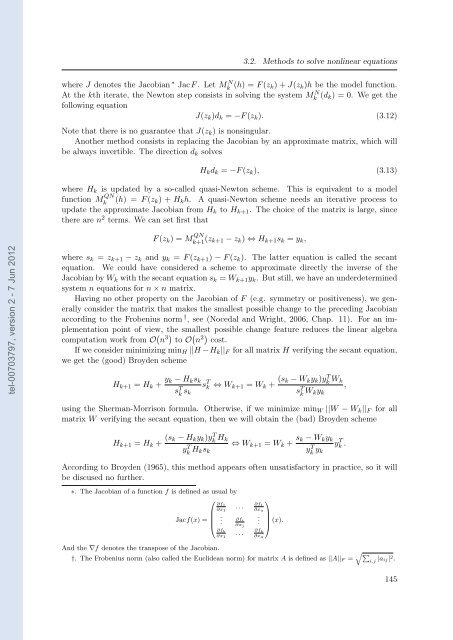Etude des marchés d'assurance non-vie à l'aide d'équilibres de ...
Etude des marchés d'assurance non-vie à l'aide d'équilibres de ...
Etude des marchés d'assurance non-vie à l'aide d'équilibres de ...
You also want an ePaper? Increase the reach of your titles
YUMPU automatically turns print PDFs into web optimized ePapers that Google loves.
tel-00703797, version 2 - 7 Jun 2012<br />
3.2. Methods to solve <strong>non</strong>linear equations<br />
where J <strong>de</strong>notes the Jacobian ∗ JacF . Let M N k (h) = F (zk) + J(zk)h be the mo<strong>de</strong>l function.<br />
At the kth iterate, the Newton step consists in solving the system M N k (dk) = 0. We get the<br />
following equation<br />
J(zk)dk = −F (zk). (3.12)<br />
Note that there is no guarantee that J(zk) is <strong>non</strong>singular.<br />
Another method consists in replacing the Jacobian by an approximate matrix, which will<br />
be always invertible. The direction dk solves<br />
Hkdk = −F (zk), (3.13)<br />
where Hk is updated by a so-called quasi-Newton scheme. This is equivalent to a mo<strong>de</strong>l<br />
function M QN<br />
k (h) = F (zk) + Hkh. A quasi-Newton scheme needs an iterative process to<br />
update the approximate Jacobian from Hk to Hk+1. The choice of the matrix is large, since<br />
there are n 2 terms. We can set first that<br />
F (zk) = M QN<br />
k+1 (zk+1 − zk) ⇔ Hk+1sk = yk,<br />
where sk = zk+1 − zk and yk = F (zk+1) − F (zk). The latter equation is called the secant<br />
equation. We could have consi<strong>de</strong>red a scheme to approximate directly the inverse of the<br />
Jacobian by Wk with the secant equation sk = Wk+1yk. But still, we have an un<strong>de</strong>r<strong>de</strong>termined<br />
system n equations for n × n matrix.<br />
Having no other property on the Jacobian of F (e.g. symmetry or positiveness), we generally<br />
consi<strong>de</strong>r the matrix that makes the smallest possible change to the preceding Jacobian<br />
according to the Frobenius norm † , see (Nocedal and Wright, 2006, Chap. 11). For an implementation<br />
point of <strong>vie</strong>w, the smallest possible change feature reduces the linear algebra<br />
computation work from O n 3 to O n 2 cost.<br />
If we consi<strong>de</strong>r minimizing minH ||H −Hk||F for all matrix H verifying the secant equation,<br />
we get the (good) Broy<strong>de</strong>n scheme<br />
Hk+1 = Hk + yk − Hksk<br />
s T k sk<br />
s T k ⇔ Wk+1 = Wk + (sk − Wkyk)y T k Wk<br />
sT k Wkyk<br />
,<br />
using the Sherman-Morrison formula. Otherwise, if we minimize minW ||W − Wk||F for all<br />
matrix W verifying the secant equation, then we will obtain the (bad) Broy<strong>de</strong>n scheme<br />
Hk+1 = Hk + (sk − Hkyk)y T k Hk<br />
y T k Hksk<br />
⇔ Wk+1 = Wk + sk − Wkyk<br />
yT k yk<br />
y T k .<br />
According to Broy<strong>de</strong>n (1965), this method appears often unsatisfactory in practice, so it will<br />
be discused no further.<br />
∗. The Jacobian of a function f is <strong>de</strong>fined as usual by<br />
⎛<br />
∂f1 . . .<br />
∂x1 ⎜ .<br />
Jacf(x) = ⎜ .<br />
⎝<br />
.<br />
. . .<br />
And the ∇f <strong>de</strong>notes the transpose of the Jacobian.<br />
∂f b<br />
∂x1<br />
∂f i<br />
∂x j<br />
∂f1<br />
∂xa<br />
.<br />
∂f b<br />
∂xa<br />
⎞<br />
⎟<br />
⎠ (x).<br />
†. The Frobenius norm (also called the Eucli<strong>de</strong>an norm) for matrix A is <strong>de</strong>fined as ||A||F =<br />
<br />
i,j |aij|2 .<br />
145
















